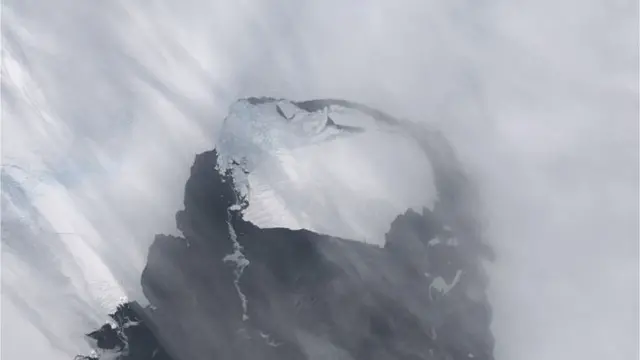Scientists have combined nearly a quarter of a century of observations to show how the region's great glaciers are losing height by up to 7m per year.
The satellite data also traces the way this thinning behaviour has spread up the length of the ice streams.
The glaciers concerned all terminate in the Amundsen Sea and are significant contributors to global ocean rise.
Their names are Pine Island, Thwaites, Pope, Smith, and Kohler.
Photo: NASA
Right now, they are dumping some 120 to 140 billion tonnes of ice a year into the ocean, which is sufficient to push up global waters by between 0.34mm and 0.40mm per annum - more than 10% of the total worldwide trend.
The glaciers' reduction in height is likely the result of the warm seawater recorded around Antarctica in recent decades.
This attacks the underside of the ice streams at the point where they cease to push out along bedrock and begin to float. Eroding this "grounding line" back towards the land makes the glaciers move faster.
"As the glaciers accelerate, they have to take ever more ice from the interior to compensate for the speed-up. This means they thin; they lose height, which we can detect from space," explained Dr Hannes Konrad from the UK'sCentre for Polar Observation and Monitoring (CPOM).
"And if there is no increase in snow and ice in the interior then this thinning will just migrate further and further upstream," the Leeds University researcher told BBC News.
Dr Konrad ispresenting his team's work here at the Fall Meeting of American Geophysical Union (AGU) - the world's largest annual gathering of Earth scientists.
His study has also just been accepted for publication in the journalGeophysical Research Letters.
Media captionAn animation that illustrates the onset and spread of thinning
It seamlessly ties together for the first time the altimetry observations from five different satellites operated by the European and American space agencies from 1992 to the present day.
What is interesting in the data is the individual responses of the glaciers to the melting assault.
They all show thinning over the period, but the behaviours are far from uniform.
Pine Island Glacier (PIG), which currently contributes more to sea level rise than any other ice stream on the planet, thins fairly steadily and relentlessly.
The lowering of its surface is already in play by the start of the satellite measurements, and now spreads back from its grounding line, along its main trunk for hundreds of km inland.
At maximum, the glacier is losing 5m in height every year and the thinning spreads inland at up to 15km per year at times.
Thwaites, on the other hand, started dropping its elevation later than the PIG and did so in two broad periods. Its delayed and episodic response means thinning on Thwaites has not spread so far inland.
Hannes Konrad: "Our study will help us understand likely future change"
Pope, Smith, and Kohler very likely began thinning earlier even than the PIG and show the sharpest height loss - up to 7m per year at the grounding line. But this behaviour is much slower to spread back along the glaciers' trunks.
"They are much smaller than the PIG or Thwaites. They have small catchments and flow along short, narrow troughs in the bedrock. So they have a very limited area where the thinning can spread into," explained Dr Konrad.
The study's results will be used to calibrate models that try to forecast the behaviour of the Amundsen Sea region in a warming world, and the consequences this will have for future sea-level rise.
It has been argued that this part of Antarctica may already be in an unstoppable retreat which would see its glaciers all collapse in coming centuries.
But co-author Prof Andrew Shepherd said there remains a good deal of uncertainty in the projections.
"It's clear from this study that the response of these glaciers to environmental change has not been uniform," he told BBC News.
"Thinning stopped and started on Thwaites, and it spread at different rates down each of glaciers.
"We have to treat these glaciers as individuals - not as a unit - if we want to make better projections of future sea-level rise."
Prof David Vaughan from the British Antarctic Survey was not involved in the study, but commended its insight - "the first time anyone's properly tracked these changes and how they propagate inland".
Scientists needed now to fully explain the different behaviours, he added.
Much research effort has already been focused on Pine Island, and Thwaites is about to get similar treatment with big UK-US field campaigns planned for the Antarctic seasons of 2019-20 and 2020-21.
"Of all these glaciers that are retreating, Pine Island has accelerated the most and is currently the furthest out of balance, but ultimately it is Thwaites in the long term, in the hundred-year timescale, that is seen as being the big concern. Because of its geometry, because the middle of its central basin just gets deeper and deeper - once you kick off its retreat, there maybe nothing to stop it."
(BBC)
 简体中文
简体中文





